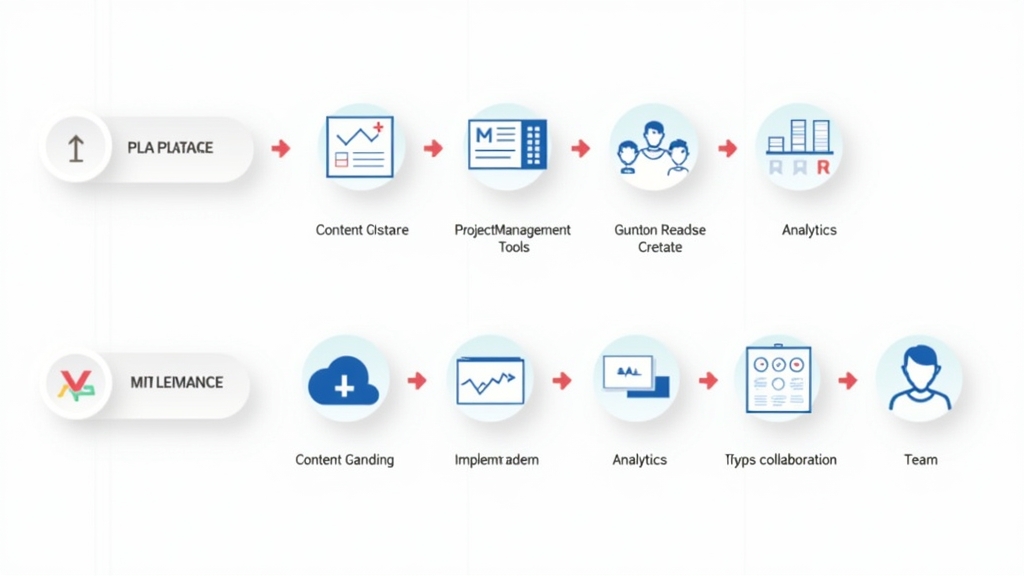Mastering Your Marketing: A Comprehensive Guide to Digital Marketing Workflow
Introduction
Digital marketing is essential in today’s world, where businesses need to connect with their audiences online. With the rise of social media, websites, and email marketing, understanding how to navigate this landscape is crucial for success. A digital marketing workflow helps streamline your efforts, ensuring that every step from planning to execution is organized and efficient. This guide will walk you through the digital marketing workflow concept and its importance in achieving your marketing goals.
Understanding Digital Marketing Workflow
Definition and Key Components
A digital marketing workflow refers to a structured process that outlines how tasks are completed within your marketing strategy. It includes several key components: planning, content creation, implementation, tracking results, and optimization. Each part plays a vital role in ensuring that your campaigns run smoothly and effectively.
The Importance of a Structured Workflow in Digital Marketing
Having a structured workflow is important because it helps teams stay organized and focused on their goals. When everyone knows their roles and responsibilities, projects can move forward without confusion or delays. Additionally, a clear workflow allows for better tracking of progress and results, making it easier to adjust strategies as needed.
Stages of the Digital Marketing Workflow
Planning and Strategy Development
The first stage involves setting clear objectives for your digital marketing efforts. You should identify your target audience, determine what platforms you’ll use (like social media or email), and decide on key performance indicators (KPIs) to measure success. This foundational work ensures that all subsequent steps align with your overall goals.
Content Creation and Curation
Once you have a plan in place, it’s time to create engaging content tailored to your audience’s needs. This could include blog posts, videos, infographics, or social media updates. Curating relevant content from other sources can also enhance your strategy by providing valuable information while establishing authority in your niche.
Implementation and Execution
With content ready to go, the next step is implementation. This means launching campaigns across chosen platforms according to the planned schedule. It’s essential during this phase to monitor engagement closely so you can respond quickly if adjustments are necessary.
Tools for Streamlining Your Digital Marketing Workflow
Project Management Tools
Using project management tools like Trello or Asana can help keep everyone on track by organizing tasks visually. These platforms allow team members to assign duties easily while monitoring deadlines.
Analytics and Tracking Software
Analytics tools such as Google Analytics provide insights into how well your campaigns perform over time. By analyzing data related to website traffic or conversion rates, you can make informed decisions about future strategies.
Automation Platforms
Automation tools like HubSpot or Mailchimp save time by scheduling posts or sending emails automatically based on user behavior patterns—freeing up more time for creative work!
Best Practices for an Effective Digital Marketing Workflow
Aligning Teams and Communication
Effective communication among team members is crucial for success in any project! Regular check-ins help ensure everyone understands their roles while fostering collaboration between departments like sales & customer service too!
Continuous Optimization and Feedback Loops
Always be prepared for change! Collect feedback regularly from both customers & team members so improvements can be made continuously throughout each campaign cycle—this keeps things fresh & relevant!
Staying Updated with Industry Trends
Digital marketing trends evolve rapidly; staying informed about new technologies & techniques will give you an edge over competitors who may not adapt as quickly!
Common Challenges in Digital Marketing Workflows
Managing Time and Resources
One common challenge many marketers face is balancing multiple projects simultaneously without sacrificing quality—prioritizing tasks effectively becomes essential here!
Overcoming Collaboration Barriers
Sometimes different teams struggle due lack of communication which leads misalignment between goals; implementing regular meetings helps bridge these gaps significantly improving outcomes overall!
Ensuring Consistent Branding Across Channels
Maintaining brand consistency across various channels requires careful attention; creating guidelines around tone/visuals ensures everything aligns perfectly no matter where customers encounter it!
Case Studies: Successful Implementation of a Digital Marketing Workflow
Many companies have successfully implemented structured workflows leading them toward greater efficiency! For example:
- Company A streamlined its content creation process using automation tools resulting in increased productivity.
- Company B improved collaboration between departments through regular meetings leading higher engagement rates across platforms.
- Company C utilized analytics software effectively identifying areas needing improvement thus boosting conversions significantly over time!
These real-life examples demonstrate how adopting effective workflows positively impacts business outcomes regardless industry type!
Conclusion
In conclusion, having a well-defined digital marketing workflow is essential for any business looking to thrive online today! By following structured processes—from planning through execution—you’ll find yourself better equipped at achieving desired results efficiently! Don’t hesitate: start implementing changes now that could lead significant improvements down road ahead!
📢 Explore More: Continue Your Journey!
If this article helped you understand the importance of digital marketing workflows better than ever before check out Mastering Content Creation Strategies! It covers powerful insights into crafting compelling content that resonates with audiences effectively.














![NEEWER 55W 18"/45cm Ring Light Kit [New Version], 5600K Dimmable ...](https://m.media-amazon.com/images/I/414QLqvZWLL._AC_.jpg)








